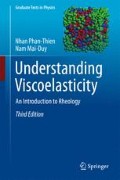Abstract
Suspension is a term used to describe an effective fluid made up of particles suspended in a liquid; examples of such liquids abound in natural and man-made materials: blood, milk, paints, inks. The concept of a suspension is meaningful only when there are two widely different length scales in the problem: l is a typical dimension of a suspended particle, L is a typical size of the apparatus, and \(l\ll L\). When this is not met, we simply have a collection of discrete individual particles suspended in a liquid. Most progress has been made with Newtonian suspensions, i.e., suspensions of particles in a Newtonian liquid.
Access this chapter
Tax calculation will be finalised at checkout
Purchases are for personal use only
Author information
Authors and Affiliations
Corresponding author
Problems
Problems
Problem 8.1
Use the instantaneous nature of the micromechanics to explain the shear reversal experiments of Gadala-Maria and Acrivos [30]. They found that if shearing is stopped after a steady state has been reached in a Couette device, the torque is reduced to zero instantaneously. If shearing is resumed in the same direction after a period of rest, then the torque would attain its final value that corresponds to the resumed shear rate almost instantaneously. However, if shearing is resumed in the opposite direction, then the torque attains an intermediate value and gradually settles down to a steady state. How would you classify the memory of the liquid, zero, fading or infinite?
Problem 8.2
Show that (8.19) is solved by
where
The effective velocity gradient tensor is \(\mathcal {L}=\mathbf {L}-\zeta \mathbf {D}\), where \(\zeta =2/(R^{2}+1)\) is a ‘non-affine’ parameter.
Problem 8.3
In the start-up of a simple shear flow, where the shear rate is \(\dot{\gamma } \), show that
and \(Q_{3}=Q_{30}\), where \(\{Q_{10}, Q_{20}, Q_{30}\}\) are the initial components of \(\mathbf {Q}\), and the frequency of the oscillation is
From these results, obtain the particle-contributed stress and the viscometric functions as
The reduced viscosity:
The reduced first normal stress difference:
and the reduced second normal stress difference:
Thus, the particles tumble along with the flow, with a period of \(T=2\pi (R^{2}+1)/\dot{\gamma }R\), spending most of their time aligned with the flow.
Problem 8.4
In the start-up of an elongational flow with a positive elongational rate \( \dot{\gamma }\), show that
so that the particle is quickly aligned with the flow in a time scale \(O( \dot{\gamma }^{-1})\). At a steady state, show that the reduced elongational viscosity is given by
Rights and permissions
Copyright information
© 2017 Springer International Publishing AG
About this chapter
Cite this chapter
Phan-Thien, N., Mai-Duy, N. (2017). Suspensions. In: Understanding Viscoelasticity. Graduate Texts in Physics. Springer, Cham. https://doi.org/10.1007/978-3-319-62000-8_8
Download citation
DOI: https://doi.org/10.1007/978-3-319-62000-8_8
Published:
Publisher Name: Springer, Cham
Print ISBN: 978-3-319-61999-6
Online ISBN: 978-3-319-62000-8
eBook Packages: Physics and AstronomyPhysics and Astronomy (R0)

